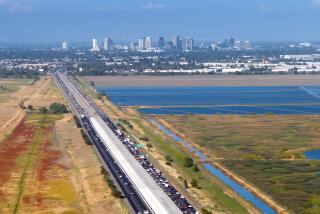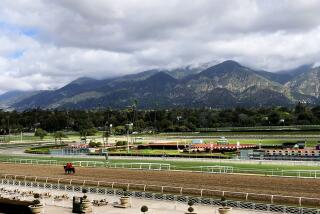Transportation Corridor Management Bears Watching
- Share via
Lower than anticipated ridership may not be cause for alarm yet on the new San Joaquin Hills toll road, which runs from San Juan Capistrano to Newport Beach. However, the board should be diligent about financial oversight and keep a close rein on administrators, who have a penchant for secrecy and feathering their own nests.
The news that the road was experiencing a 51% revenue shortfall from projections was one of the first major pieces of Wall Street feedback on a major transportation innovation for California. In official circles, it was greeted as a blip on the screen, with the issuer J.P. Morgan Securities Inc. noting that an early shortfall is not unlike those experienced by other new toll roads. It said that as the economy continues to pick up, the cars will come.
The report took note of confusing road signs, the addition of carpool lanes on the nearby Santa Ana Freeway and a longer than expected period for drivers to become familiar with the road. Transportation Corridor Agencies officials said that there had been faulty projections made in 1992 when the bonds were sold, and they argued that the prolonged recession has kept people off the road.
The road always has had an element of uncertainty, given its experimental nature as an alternative to a staple of California living, the freeway. This particular road was approved a long time ago, and indeed, so long back that there has always been a question of whether it would win user approval once built.
Beyond whether the road is needed, there always has been the larger matter of how to pay for it. Lurking in the background of the road’s upbeat financing projection always has been the uncomfortable question: Would the public one day be asked to bail it out?
All of this is in anticipation of the March 1999 date when the agency must begin making interest payments. In noting that the projec-tions of usage were off, the agency staff has said there has been an increase of 2% to 3% per week in ridership.
While there may be no immediate cause for alarm, the board that oversees the agency ought to redouble its efforts to provide strict oversight. This is an agency that has raised eyebrows before with its lavish perks for executives and freewheeling management style that at times appears openly contemptuous of public oversight. A “we know best” philosophy won’t do. The board should resist any attempts to limit public discussion of the refinancing of bonds and matters related to the fiscal condition of the road.
The report is not cause for alarm, but a flag has been raised. For the general public, a “not to worry” assertion from the leadership of the agency should be taken with a grain of salt. The board should hold those with fiduciary responsibility to a full public accounting.
Beyond that, there is the question of whether some remedial action is necessary now to raise ridership. We have noted the confusion arising from signs before. Perhaps most important, it is prudent to examine the notion of how much people are willing to pay to ride.
There is no escaping the conclusion that it is an expensive proposition for people to commit to riding the road to and from work each working day. Four dollars each day amounts to $20 a week, which while not a great amount of money is a substantial commitment in the family budget of many working folks--say, about $1,000 a year. Another way to think of it is that this would put a significant dent in most people’s annual take-home raises.
The board should be willing to revisit the pricing issue and to make other adjustments as needed. It would be better to do any necessary marketing and operational fine-tuning now, in the interest of making the favorable predictions for the future a reality.
More to Read
Sign up for Essential California
The most important California stories and recommendations in your inbox every morning.
You may occasionally receive promotional content from the Los Angeles Times.










